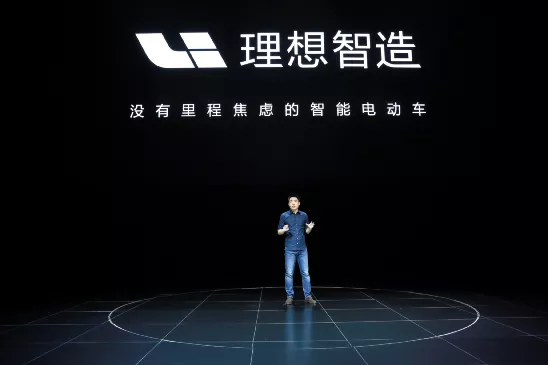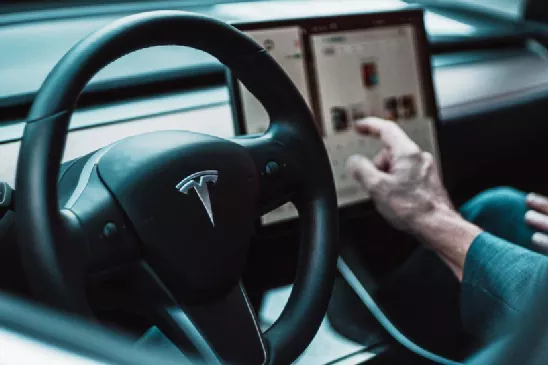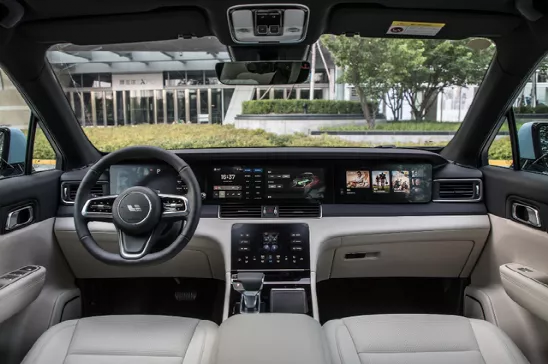Xingbai Ren Media Focuses On the Evolution of the Automotive Industry Chain
Author: Zheng Wen
On August 12th, after a year of being listed in the US stock market, the Ideal car went public the second time in the Hong Kong stock exchange. The stock price remained steady on its first day of trading and plummeted during midday.
There were already signs of these unfavorable results prior to the public sale. During the public sale period, the Ideal car received 5.5 times more subscriptions, while one month before, the XPeng Motors received 14.73 times more financing subscriptions before listing on the Hong Kong stock market. Before being listed, the Ideal car declared its IPO pricing at 118 Hong Kong dollars, 21.3% lower than the expected highest issuance price of 150 Hong Kong dollars per share.
“The company does not care about short-term stock prices internally; It considers more about the efficient and convenient financing channels to reserve enough ammunition for the next stage of the competition.” Said Shen Yanan, the co-founder and CEO of Ideal car, in response.
Regardless, the stock price’s reaction shows that Ideal car has not met the capital market’s expectations at present.
What Is Financing for?
Shen Yanan claimed that the main objective of raising funds was to reserve funds for the next generation of Ideal car products’ research and development, which would focus on three aspects: first, electric drive technology, including the next-generation range extension technology, and 400kW high-speed charging technology; second, self-driving technology; third, intelligent cabins.
The prospectus shows that 20% of the net proceeds will provide funds for researching and developing high-pressure pure electric vehicle technology, platforms, and future models; 15% will be used for autonomous driving research and development; 10% will be used for range extender platform development; 45% will be used for expanding infrastructure, marketing, and promotion; 10% will be used for operational capital and other general company purposes.
The several core technology components involved in it, including 4C fast charging high-rate battery packs, high-pressure platforms based on the third-generation SiC semiconductor materials, CO2 refrigerant thermal management systems, high-power charging networks, L4-level autonomous driving capabilities, are undoubtedly techniques that Tesla, NIO, XPeng Motors have been reserving for years.
Ideal cars have begun to travel the same path several years later. As for whether its technological advancement is comparable to the industry’s previous efforts, time will verify this.
At this point, Ideal’s entry into the pure electric vehicle market has benefited from past industry efforts by enabling it to deliver cost benefits. However, every company can share these fruits.
The dilemma that Ideal car is facing is that its platform capabilities have not yet been verified. As we all know, Ideal car has only sold one Ideal ONE model, even though the company has been established for six years.Perhaps for the purpose of IPO financing, in February of this year, the automotive start-up, Li Auto, proposed an ambitious strategic goal: to achieve a 20% market share and 1.6 million unit sales by 2025, becoming the number one smart electric vehicle company in China and ranking top three in the world. According to Shen Yanan, Li Auto has a very detailed plan to achieve the target.
Regarding the 20% market share, the company has a detailed plan to achieve it. In terms of research and development, the company is set to launch its second-generation Extended-Range Electric Vehicle platform, or X-Platform, in 2022. The pure electric platforms include Whale and Shark Platforms, which will start to roll out products in 2023.
In terms of production capacity, Li Auto also has corresponding capacity planning at its Beijing factory. “From the perspective of the supply chain, to achieve a 20% market share and 1.6 million unit sales, the supply capacity requirement for the entire supply chain is very high, especially for the core components related to smart electric vehicles. We are laying out plans in collaboration with partners,” said Shen Yanan.
In terms of product planning, Li Auto plans to introduce an Extended-Range Electric Vehicle full-size luxury SUV in 2022, and two more Extended-Range Electric Vehicle SUVs in 2023. From 2023 onwards, the company will launch at least two pure electric models every year.
In other words, Li Auto will not be able to launch its first pure electric vehicle until 2023, after its competitors have had two more years of experience producing electric cars. “Capital markets still favor pure electric vehicles. Therefore, the launch of Li Auto’s pure electric vehicle is a key milestone,” said an investor.
In July, Li Auto ranked first among the new car-making forces, including “NIO” and “Xpeng,” with a delivery volume of 8,589 units. This achievement was based on only one mass-produced model, the Li ONE. However, the capital market seems to not fully appreciate this achievement. “Capital values imagination,” said an investor. Unfortunately, Li Xiang has never been good at catering to the capital market or creating imagination space like other entrepreneurs do.
Entrepreneurs in the second venture usually have an easy time navigating the capital market and do not need to worry about financing. However, this is not the case for Li Xiang. There is a popular saying in the venture capital circle: “The most reliable relationship is one that has made money together.” However, many investment institutions have only heard about Autohome, but not fully understand the founder, Li Xiang.The statistics show that before the first model was launched, NIO has raised a total of 14.5 billion yuan in five rounds of financing, while XPeng Motors’ financing amount has exceeded 10 billion yuan, and the financing amount of Ideal Cars is less than 5 billion yuan.
“Li Xiang is a product manager who considers actual market needs,” said Zhang Junyi, former managing partner of NIO Capital.

In the early stage of entrepreneurship, Ideal Cars had planned to enter the car-making market with the SEV small car project, but later had to announce the stoppage of the small car project due to policy reasons. After in-depth market research, Ideal Cars defined the technical route of the first model as a range-extended electric vehicle.
You can say that Li Xiang is an excellent product manager, but it is difficult to say that he is a crazy dreamer. Even when shouting out strategic goals, while other founders talk about blueprints and visions, he only shouts out a sales target.
The founder’s tepidness has also led to the mediocrity of the brand. In consumers’ minds, NIO’s user enterprise label is deeply rooted, and XPeng’s technology and intelligent labels have long been attached, but Ideal Cars has never had a distinct brand label.
On the other hand, Tesla, which is good at dealing with capital, can always draw up new attractively unrealistic plans to inspire the imagination of investors and can actually deliver those plans, like revenue from FSD software. In this quarter’s earnings call, Tesla CFO Zachary Kirkhorn mentioned that the potential for large revenues from FSD fees paid on a subscription basis has become clearer.
Co-founder of Loup Ventures, Gene Munster, said that the operating profit Tesla gets from early purchases and subscriptions of FSD will increase from $600 million in 2021 to $102 billion in 2032. That’s 170 times profit growth in ten years, incredible. FSD is a potentially highly profitable business due to the high gross profit and low marginal cost characteristics of the software business.
It should be noted that the newly launched FSD software package by Tesla will likely generate more revenue with the addition of the monthly subscription model compared to the previous one-time purchase model. The “subscription model” has already brought abundant profits to many companies. For example, Apple’s software service revenue was as high as $17 billion in the first quarter of this year.
 Of course, XPeng and NIO have also tasted the sweetness. XPeng Motors’ financial report shows that in 2020, the revenue of its XPILOT3.0 autonomous driving system software package was 50 million yuan, and in the first quarter of this year, it reached 30 million yuan, which has exceeded half of last year’s revenue. NIO’s gross profit margin reached an astonishing 19.48% in the first quarter of this year, and the subscription fee for autonomous driving software package is also one of the most direct influencing factors.
Of course, XPeng and NIO have also tasted the sweetness. XPeng Motors’ financial report shows that in 2020, the revenue of its XPILOT3.0 autonomous driving system software package was 50 million yuan, and in the first quarter of this year, it reached 30 million yuan, which has exceeded half of last year’s revenue. NIO’s gross profit margin reached an astonishing 19.48% in the first quarter of this year, and the subscription fee for autonomous driving software package is also one of the most direct influencing factors.
Ideal Auto has its own persistence on this. Shen Yanan said, “Ideal Auto does not want to obtain software income through a subscription model based on the needs of the capital market. We still think from the perspective of user experience. For example, we have always said that autonomous driving is standard configuration because we are making cars for families. Autonomous driving is related to safety configuration and should be standard configuration rather than a so-called subscription model.”
It should be noted that in the 2021 model of Ideal ONE, NOA automatic navigation assisted driving was one of the promotion points, but the function has not been pushed to users yet.
Ideal Auto is also very conservative in terms of R&D investment or, in other words, it has not been able to provide more imaginative space. As the financial report shows, the total R&D expenditure of Ideal Auto was 1.1 billion yuan in 2020, while NIO’s R&D expenses for the same period were 2.487 billion yuan, and XPeng’s R&D expenses for the same period were 1.726 billion yuan.
A senior industry analyst bluntly said, “Ideal Auto is the company among the top three new forces in the auto-making industry that has the least technical content, and it is also the car company with the lowest growth space and the highest risk.”
Capital may be short-sighted, but it cannot be denied that it is often smart.

This article is a translation by ChatGPT of a Chinese report from 42HOW. If you have any questions about it, please email bd@42how.com.